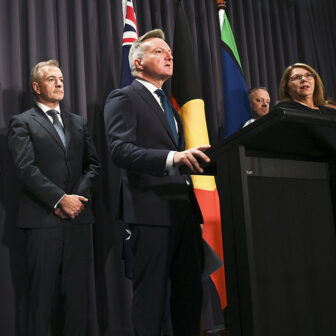The Global Burden of Disease Study calls air pollution the world’s greatest environmental health risk. It causes around 5000 premature deaths in Australia each year by increasing the risk of heart disease, stroke, diabetes, lung cancer and other diseases. Yet successive governments have failed to lift standards for petrol quality, a key contributing factor to air pollution. In fact, the petrol most Australians use to fill their cars (known as 91 RON) is so poor in quality that it would be illegal in almost any other developed country.
Global consultancy Stratas Advisors recently ranked Australia’s fuel quality as eighty-fifth in the world — between Argentina’s and Tanzania’s — on the basis of its high proportion of sulphur, a key health and environmental toxin. This is a worse ranking than all European countries, the United States, Canada, Japan, China and India, and most other countries in the Asia-Pacific region, including Singapore, Malaysia, the Philippines, New Caledonia, Fiji and New Zealand.
Australia’s poor fuel is well known internationally and recently became an issue in negotiations over the EU–Australia free trade agreement. Some car manufacturers refuse to supply certain of their new models to Australia or to downgrade the engines of cars designed for the cleaner fuel available in Europe, because of the risk of damage from our low-quality petrol.
And yet, when the regulations in the Fuel Quality Standards Act 2000 were reviewed in 2019, the federal government ignored calls from health experts and organisations to bring Australia’s fuel standards into line with best overseas practice. Expert advice was trumped by opposition from Caltex, Mobil, Viva Energy and BP, the oil companies that make up Australia’s domestic oil refining sector.
The Global Burden of Disease Study says that one of its “most alarming” findings is that “about a third of the burden of stroke is attributable to air pollution.” Air pollution is known to damage the lungs, heart and brain, it says, but “the extent of this threat seems to have been underestimated.”
Australian-based research, including the landmark Australian Child Health and Air Pollution Study, has demonstrated that even low levels of exposure to air pollution can increase the severity of asthma among children. A study recently published in the European Respiratory Journal found that Australians aged forty-five to fifty who live less than 200 metres from a major road have a 50 per cent higher risk of asthma, wheeze and lowered lung function over a five-year period than those who live further from a major road.
Lung cancer is another well-documented effect of air pollution. But newer research has demonstrated causal links between air pollution and other forms of cancer, such as pancreatic, colorectal and bladder, as well as increased mortality from all cancers. Emerging research is also demonstrating a link between air pollution and obesity, Alzheimer’s disease, dementia, Parkinson’s disease, allergic reactions and ADHD.
Perhaps the most serious impact of air pollution is on the brain and respiratory-system development of babies in utero. The link between premature birth and air pollution has been known for some time, but reports of a dramatic drop in pre-term births during the Covid-19 pandemic have led some researchers to speculate that reduced exposure to air pollution may be part of the reason. Evidence even suggests that exposure to air pollution can cause DNA changes that can then be passed on to future generations.
Despite all this evidence, public awareness of the dangers of air pollution remains low. This partly reflects the fact that the harms of air pollution can be difficult to spot at the individual level. Like smoking, air pollution increases an individual’s risk of serious conditions. Identifying the population-wide harms of air pollution means extrapolating data from large-scale epidemiological studies that clearly demonstrate the link between air pollution and serious health conditions.
Using 2017 data, the Clean Air and Urban Landscapes Hub and the Melbourne Energy Institute put the Australian health costs of air pollution each year at $17.8 billion, with an additional $4.5 billion in “welfare losses and foregone labour output.” On those figures, air pollution’s health costs are greater than those of obesity ($11.8 billion in 2017–18) and close to those of smoking ($19.2 billion in 2015–16).
Not only are motor vehicles Australia’s third-largest source of greenhouse gas emissions, they also have a greater direct impact on health than the same level of emissions from other sources — factories, for example — because of higher levels of exposure in the population.
According to the State of Global Air report, the small particulate matter (PM2.5) produced by vehicle emissions was responsible for an estimated 1715 premature deaths in Australia in 2015, more than the annual road toll. (Other harmful components of vehicle emissions are not included in this figure, and nor are coal-fired power stations, factories, wood-burning heaters and other causes of air pollution.) The International Council on Clean Transportation estimates that reducing toxic materials in vehicle emissions could cut premature deaths by around 75 per cent.
Sulphur in fuel increases the production of sulphur dioxide, nitrous oxides, carbon monoxide and other toxic gases. It also creates harmful small particulate matter that can be inhaled and can enter the bloodstream. Fuels high in sulphur also prevent the effective operation of emissions control technology, such as particulate filters, which is why car manufacturers including Volkswagen (anxious to regain its reputation after an earlier fuel scandal) will not sell their most eco-friendly cars in Australia.
Clare Walter, a PhD candidate researching air pollution and policy at the University of Queensland, says the move to low-sulphur fuel would have the dual benefit of supporting the uptake of vehicles with the most advanced emission controls while reducing toxic emissions from Australia’s current fleet.
“Our current standards are in line with those introduced in Europe in 2009 — they are known as Euro 5,” Walter tells me. “Australia did not mandate these standards until 2016, by which time Europe had moved onto more stringent standards, Euro 6.”
Why that laggard status has persisted is a case study in how clear medical evidence can be outweighed by well-organised and well-resourced industry lobbying. Despite extensive evidence of the harms of air pollution, a five-year government review into Australia’s fuel standards concluded in 2018 by recommending no changes to fuel quality until 2027.
The process began with the release of a discussion paper on vehicle emissions in December 2016, by the then environment minister (now health minister) Greg Hunt. “Around 17 per cent of Australia’s greenhouse gas emissions are from transport,” he said bluntly. “In cities such as Sydney on-road motor vehicles can contribute around 60 per cent of some noxious air pollutants.” The following year, his successor as environment minister, Josh Frydenberg, declared that “Australia’s petrol quality is the lowest in the OECD or seventieth in the world.”
Hunt’s discussion paper contained five options:
A. No change in Australia’s fuel standards (maximum allowable sulphur content in standard petrol remains 150 parts per million, or ppm).
B. Harmonisation with European standards within two to five years (low grade petrol phased out, maximum sulphur in premium unleaded petrol limited to 10 ppm).
C. As with option B, but low-grade petrol retained (maximum allowable sulphur content 10 ppm)
D. Harmonisation with the (stricter than Europe) standards recommended by the Worldwide Fuel Charter (maximum allowable sulphur content 10 ppm)
E. A gradual improvement in quality standards from 2020 with a review in 2022 (maximum allowable sulphur content for standard petrol 50 ppm) heavily favouring a reduction in sulphur levels to 10 ppm, the maximum allowed in most other developed countries.
Submissions from health and environmental groups strongly supported the options that would bring Australia’s fuel standards in line with Europe, most other developed countries, and even the United States — option B or, failing that, D.
But the government’s subsequent draft regulation impact statement added a sixth option suggested by the downstream petroleum sector, represented by the Australian Institute of Petroleum, which involved no action on sulphur until 2027. The institute argued that the refining industry would need to invest around $979 million, “which may threaten the economic viability of the remaining refineries in Australia,” and stressed that the price of petrol could rise as a consequence — two possibilities that no doubt influenced government decision-making.
Robyn Schofield from the School of Earth Sciences at the University of Melbourne is one who challenges the institute’s argument. All the Australian refiners are multinational and operate in jurisdictions requiring a maximum 10 ppm of sulphur, she says. There is no reason they can’t bring the same technology to Australia.
Schofield also argues that the cost of upgrading refineries is outweighed many times over by the health costs associated with increased mortality and morbidity caused by poor fuel quality. If the government is concerned about potential petrol price rises it could fund the upgrade itself, she says, out of the $6 billion per year collected in petrol excise, for example. The cost-effectiveness of such a move would be incontrovertible given that the cost of the $979 million upgrade would be significantly lower than the $17.8 billion in annual health costs associated with vehicle emissions.
The Institute of Petroleum also argues that the generally good quality of Australia’s air undermines the case for improving fuel standards. Not so, responds Clare Walter. “Average” measures of air quality are not an accurate representation of the risks of exposure to pollution in specific locations and among specific populations. “The air-quality models used in the government’s analysis were designed to reflect regional air quality rather than roadside air-quality conditions,” she says. “Yet much of our population lives in big cities and spends a considerable amount of time exposed to roadside pollution.”
We also need to recognise exposure among people at higher risk from air pollution, such as young children, people with respiratory conditions and the elderly, says Walter. She also questions the validity of calculating health risks based on international epidemiological studies that use finer-grained data from overseas.
Health groups contend that the calculations used by the government in assessing the cost-effectiveness of different policy options fail to take account of Australia’s underlying population health. Asthma and allergies are more prevalent here than in the United Sates and EU countries, for example, making our population more vulnerable to air pollution.
None of these or other points made by health organisations appear to have been considered by the government. Health groups and experts were limited to providing written submissions to the regulatory review process, and were then largely ignored. The review’s “stakeholder forums” and face-to-face meetings almost exclusively involved industry representatives and were dominated by the Australian Institute of Petroleum. Even high-profile government-funded organisations — the Clean Air and Urban Landscapes consortium, the Clean Air Society of Australia and New Zealand, the Centre for Air Pollution, Energy and Health Research, or CAR, and peak bodies in air, energy and health research — were excluded from full participation.
The experience of Graeme Zosky, an expert on the health impacts of air pollution who was the lead author of CAR’s submission, was typical. As deputy director of the Menzies Institute for Medical Research and a professor of physiology at the Tasmanian School of Medicine, he recalls being contacted by a consultant for input on the evaluation measures for the policy options. But he wasn’t invited to any of the stakeholder forums or interviewed by the department.
Also lacking has been any health-sector representation on the two major committees with a role in fuel standards. The health minister isn’t among the members of the Ministerial Forum on Vehicle Emissions, which is responsible for coordinating the government’s regulation of motor vehicle emissions, and the health department is not represented in its secretariat.
Interestingly, the forum’s influence on policymaking is hard to gauge because details of its meetings are not publicly available — a lack of accountability highlighted by senator Rex Patrick when he questioned a representative of the Department of Infrastructure, Regional Development and Cities during a Senate inquiry hearing in August 2018:
Senator Patrick: I presume the ministerial forum produces minutes.
Mr Foulds: No, they don’t produce minutes as such…
Senator Patrick: Do you have officials go along that take notes?
Mr Foulds: The forum has met without officials and with officials.
Another key advisory group on fuel standards is the Fuel Standards Consultative Committee, whose members include representatives of all states and territories, the Commonwealth, fuel producers, an environment protection body and a consumer interest body, but no health expert or representative of the health sector. The minister is required to consult the committee before creating or amending a fuel quality standard.
The lack of health-sector involvement in these two committees and their secretariats probably contributed to the focus on the oil industry’s perspective rather than health impacts in the final regulation impact statement, released in August 2018. The statement includes an analysis of policy options B, C and F (the industry’s option) relative to the status quo (option A), based on the following criteria:
1. Achieve appreciable health and environmental outcomes
2. Ensure the most effective operation of engines
3. Facilitate adoption of better engine and emission control technologies
4. Achieve harmonisation with European standards, as appropriate
5. Minimise regulatory burden
6. Maximise net national benefits.
The analysis demonstrated that option F only partially met the first criterion: appreciable health and environmental outcomes. It also showed that option B was the only one that would decrease greenhouse gas emissions.
The final regulatory impact statement concedes that option B was supported by approximately 60 per cent of submissions because it would deliver maximum health and environmental benefits. It also states that the proposal to reduce sulphur to 10 ppm was “supported almost unanimously — only one submission (confidential) expressed a preference to maintain current levels of sulphur in petrol.”
Yet the statement opts for the industry’s option F on the basis that it avoids the cost of upgrading oil refineries. It also makes clear that this was the option supported by the downstream petroleum sector. In relation to sulphur, the statement says that delaying any reduction until 2027 is the “best option for the viability of domestic refineries” and therefore “the best option from a system-wide perspective.”
Health experts’ detailed criticism of the methodology used to determine cost-effectiveness is not covered in the statement; instead, it focuses almost exclusively on the positions of the Australian Institute of Petroleum and other industry organisations. Tellingly, its summary of “key views from stakeholders” fails to mention any of the health and environmental groups that provided feedback on the policy options.
Following the publication of the final regulatory impact statement, the new fuel standard regulations were introduced into parliament last year.
The failure of the standards review to improve Australia’s fuel quality shows how interest groups with deep pockets can dissuade governments from making changes that reflect expert advice and promote public health. That influence explains why Australia lags behind most other developed countries in reducing the level of toxic material produced by our seventeen million cars, even though 90 per cent of Australians live in urban areas and are directly affected by vehicle emissions.
The implications for dealing with other threats to public health, such as climate change, obesity, poverty and inequality, are obvious.
One of the most frustrating aspects of this issue, according to Robyn Schofield, is that Australians “have been lulled into a false sense of security and don’t understand that these standards are being dictated by the petroleum industry.” Add to this the fact that improving fuel quality is relatively simple compared with other strategies to reduce air pollution, such as phasing out coal-fired power. Schofield describes better standards as potentially an “easy public health win” that should be a “no brainer” for governments.
At the very least, as the Clean Air and Urban Landscapes consortium suggested in its submission, the health department should be included formally in developing fuel standards. The Heart and Stroke Foundations and other public health groups could play an important role from outside by using their profile and lobbying expertise to support scientists taking on a greater advocacy role. In contrast with both the American and British Heart Associations, neither of these organisations currently takes a position on the health impacts of air pollution.
Australia has relied on high-quality scientific and medical expertise to steer us through the Covid-19 pandemic. But we don’t have a good track record in supporting research scientists outside crises. The lag between public health research findings and policy changes can be significant: it took twenty years from the discovery of the health harms of smoking until the first health warnings appeared on tobacco products, and another twenty years before tobacco advertising was banned.
We shouldn’t have to wait forty years for action on fuel quality. But history shows that overcoming the influence of well-resourced interest groups and the inertia of governments and entrenched bureaucratic cultures won’t happen without a struggle. •




